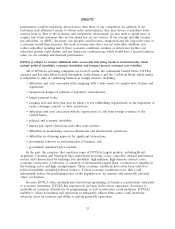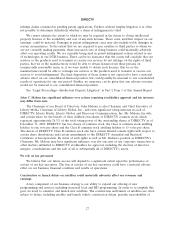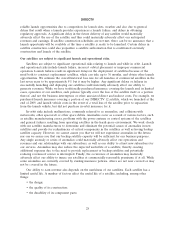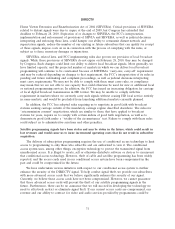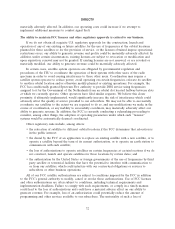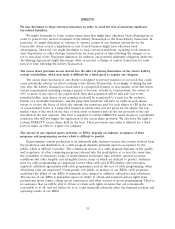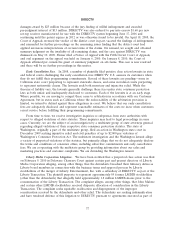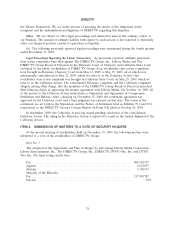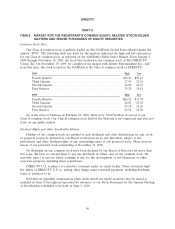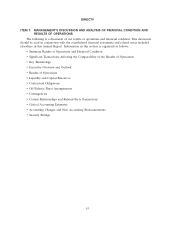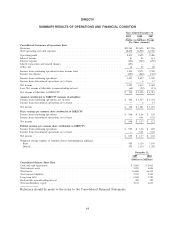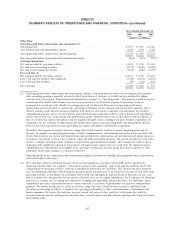DIRECTV 2009 Annual Report Download - page 47
Download and view the complete annual report
Please find page 47 of the 2009 DIRECTV annual report below. You can navigate through the pages in the report by either clicking on the pages listed below, or by using the keyword search tool below to find specific information within the annual report.DIRECTV
We may determine to forgo certain transactions in order to avoid the risk of incurring significant
tax-related liabilities.
We might determine to forgo certain transactions that might have otherwise been advantageous in
order to preserve the tax-free treatment of the Liberty Transaction or the News/Liberty transaction. In
particular, we might determine to continue to operate certain of our business operations for the
foreseeable future even if a liquidation or sale of such business might have otherwise been
advantageous. Moreover, we might determine to forgo certain transactions, including stock issuances,
asset dispositions or other strategic transactions for some period of time following the mergers so as
not to run afoul of the 50-percent limitation. In addition, our potential indemnity obligation under the
Tax Sharing Agreement might discourage, delay or prevent a change of control transaction for some
period of time following the Liberty Transaction.
The excess share provision in our charter has the effect of placing limitations on the shares held by
certain stockholders, which may make it difficult for a third party to acquire our company.
The excess share provision of our charter is designed to prevent transfers of our stock that could
cause potentially adverse tax effects relating to the Liberty Transaction. Accordingly, if during the first
year after the Liberty Transaction closed there is a purported transfer or non-transfer event that meets
certain requirements, including causing a person to become, actually or constructively, the owner of
10% or more of any class of our capital stock, then that acquisition will be null and void to the
intended holder, such shares of our common stock will be transferred to a trust for the exclusive
benefit of a charitable beneficiary, and the purported transferee will have no rights in such shares,
except to receive the lesser of (i)(A) the amount the transferee paid for such shares or (B) in the case
of a non-transfer event or a purported transfer in which value was not given for the shares, the fair
market value of the stock on the date of such event or transfer and (ii) the net proceeds of the sale
described in the next sentence. The trust is required to sell the DIRECTV excess shares to a permitted
transferee who will not trigger the application of the excess share provision. We also have the right to
redeem DIRECTV excess shares held by the trust. These provisions may make it difficult for a third
party to make an offer to acquire our company.
The success of our regional sports networks, or RSNs, depends on audience acceptance of their
programs and programming services which is difficult to predict.
Entertainment content production is an inherently risky business because the revenue derived from
the production and distribution of a cable program depends primarily upon its acceptance by the
public, which is difficult to predict. The commercial success of a cable program depends on the quality
and acceptance of other competing programs released into the marketplace at or near the same time,
the availability of alternative forms of entertainment and leisure time activities, general economic
conditions and other tangible and intangible factors, many of which are difficult to predict. Audience
sizes for cable programming are important factors when cable and DTH satellite video providers
negotiate affiliation agreements with cable programmers and, in the case of cable programming, when
advertising rates are negotiated. Consequently, low public acceptance of our RSNs’ cable programs
could hurt the ability of our RSNs to maintain rates charged to affiliates, subscribers and advertisers.
The success of our RSNs is dependent upon our ability to obtain and retain broadcast rights from
professional sports teams, college sports conferences and other sources of sports programming. There is
no assurance that we will be able to obtain or retain such rights on terms that are economically
reasonable or at all, and our failure do to so could materially adversely affect the financial position and
operating results of our RSNs.
35


